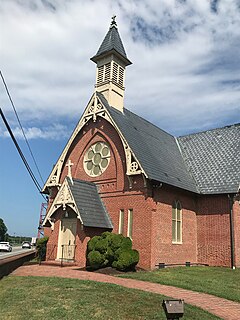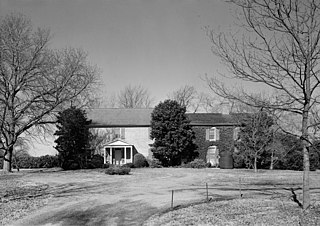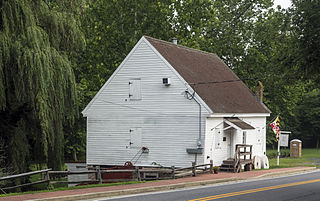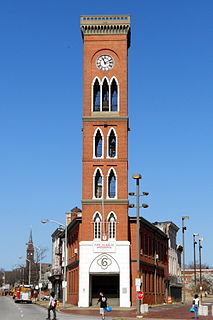
Druid Hill Park is a 745-acre (3.01 km2) urban park in northwest Baltimore, Maryland. Its boundaries are marked by Druid Park Drive (north), Swann Drive and Reisterstown Road, and the Jones Falls Expressway / Interstate 83 (east).
The Wye River is a 16.3-mile-long (26.2 km) tributary of the Chesapeake Bay, on the Eastern Shore of Maryland. It was named by the Lloyd family, Edward Lloyd (delegate), and Edward Lloyd, after the River Wye in the United Kingdom. It falls within Queen Anne's County and Talbot County, and joins the Miles River near its mouth to the Eastern Bay. The river is popular with recreational boaters because of its secluded anchorages, fishing, crabbing and proximity to the tourist attractions of St. Michaels, Maryland. Like many rivers on the Chesapeake Bay, the Wye is largely tidal. The river's features include the 2,800-acre (11 km2) Wye Island, most of which is part of the Wye Island Natural Resources Management Area, managed by the Maryland Department of Natural Resources State Forest and Park Service. William Paca, the third governor of Maryland and a signatory to the Declaration of Independence, once owned the island.

The Stevensville Historic District, also known as Historic Stevensville, is a national historic district in downtown Stevensville, Queen Anne's County, Maryland. It contains roughly 100 historic structures, and is listed on the National Register of Historic Places. It is located primarily along East Main Street, a portion of Love Point Road, and a former section of Cockey Lane.

The William Paca House is an 18th-century Georgian mansion in Annapolis, Maryland, United States. William Paca was a signatory of the Declaration of Independence and a three-term Governor of Maryland. The house was built between 1763 and 1765 and its architecture was largely designed by Paca himself. The 2-acre (8,100 m2) walled garden, which includes a two-story summer house, has been restored to its original state.

The Brice House is, along with the Hammond-Harwood House and the William Paca House, one of three similar preserved 18th century Georgian style brick houses in Annapolis, Maryland. Like the Paca and Hammond-Harwood houses, it is a five-part brick mansion with a large central block and flanking pavilions with connecting hyphens. Of the three, the Brice House's exterior is the most austere, giving its brickwork particular prominence. The Brice House was declared a National Historic Landmark in 1970.

The Chase–Lloyd House is a historic house at 22 Maryland Avenue in Annapolis, Maryland. Built in 1769–1774, it is one of the first brick three-story Georgian mansions to be built in the Thirteen Colonies, and is one of the finest examples of the style. Its interiors were designed by William Buckland. Its construction was started for Samuel Chase, who would later be a signatory to the Declaration of Independence and Associate Justice of the Supreme Court, but Chase sold the building unfinished to Edward Lloyd IV in 1771. Lloyd completed the house in 1774 with assistance from Buckland and another architect, William Noke. The house remained in the Lloyd family until 1847, when it was sold to a relation of Chase. Hester Anne Chase was the daughter of Jeremiah Townley Chase who was Samuel Chase's cousin. When she died, she left the house to her 3 orphan nieces, Francis, Matilda, and Hester. In 1888 the house was bequeathed for use as a home for elderly women by the will of the last living niece, Hester. It continues in this use today. While the upper floors are off limits to visitors, the main floor and the extensive gardens are open to the public.

The First Unitarian Church is a historic church and congregation at 12 West Franklin Street in Baltimore, Maryland. Dedicated in 1818, it was the first building erected for Unitarians in the United States. The church is a domed cube with a stucco exterior. The church, originally called the "First Independent Church of Baltimore", is the oldest building continuously used by a Unitarian congregation. The name was changed in 1935 to "The First Unitarian Church of Baltimore " following the merger with the former Second Universalist Church at East Lanvale Street and Guilford Avenue in midtown Baltimore. The American Unitarian Association and the Universalist Church of America (established 1866) representing the two strains of Unitarian Universalism beliefs and philosophies merged as a national denomination named the Unitarian Universalist Association in May 1961.

Riversdale, is a five-part, large-scale late Georgian mansion with superior Federal interior, built between 1801 and 1807. Also known as Baltimore House, Calvert Mansion or Riversdale Mansion, it is located at 4811 Riverdale Road in Riverdale Park, Maryland, and is open to the public as a museum.

St. Peter's Church, also known as the Church of St. Peter the Apostle, is a nearly 200-years-old Roman Catholic church located in Maryland's Eastern Shore near Queenstown. It is a prominent landmark along U.S. Route 50 in Maryland, which is part of the main route from Washington and Baltimore to Atlantic beach resort towns in Maryland and Delaware.

Bowlingly, also known as Neale's Residence and The Ferry House, is a historic home located at Queenstown, Queen Anne's County, Maryland, United States. It is a large brick dwelling house constructed in 1733 on a bluff overlooking Queenstown Creek. The original house is a two-story brick structure that is seven bays long and one room deep, with flush brick chimneys at either end of the pitched gable roof. On August 13, 1813, a flotilla of British Royal Navy warships landed at Bowlingly's wharf during the War of 1812. British troops who disembarked from the warships proceeded to sack the home before being engaging the local Maryland militia.

The Wye Mill is the oldest continuously operated grist mill in the United States, located at Wye Mills, Queen Anne's County and Talbot County, Maryland, United States. It is the earliest industrial site on the Eastern Shore in continuous use; dating to the late 17th century. It is a wood-frame, water-powered grist mill, with a 19th-century 26 HP 10-foot-diameter (3.0 m) Fitz steel overshot wheel. The mill retains nearly all of its late-18th-century equipment. The Wye Mill was one of the first grist mills to be automated with the Oliver Evans process, which is still in use today.

This is a list of the National Register of Historic Places listings in Pitkin County, Colorado.

Engine House No. 6 is a historic fire station located at Baltimore, Maryland, United States. This two-story brick building features a 103-foot Italian-Gothic tower at the apex of its truncated triangular shape. It was built in 1853–54, and the tower is said to be a copy of Giotto's campanile in Florence, Italy.

Paca Street Firehouse, also known as Truck House No. 2, is a historic fire station located at Baltimore, Maryland, United States. The architect of Paca Street Firehouse is John E. Lafferty. It is a 1909 two-story brick structure with a highly detailed stone Renaissance Revival façade. The principal space is a large room subdivided at the Paca Street end into offices. It is one of three early 20th century firehouses standing and is the only one to retain its original features, particularly in the interior.

William Paca was a Founding Father of the United States who was a signatory to the Continental Association and the United States Declaration of Independence. He was a Maryland delegate to the First Continental Congress and the Second Continental Congress, governor of Maryland, and a district judge of the United States District Court for the District of Maryland.
The Aspen Institute Wye River Conference Centers are a set executive-retreat facilities run by the Aspen Institute on a campus overlooking the Wye River on the Eastern Shore of Maryland.

The Wye River plantation, or Wye Hall was the Eastern Shore of Maryland home of William Paca, a signer of the Declaration of Independence, constructed in 1765, and extensively renovated in 1790 by John Paca, with Joseph Clark as architect, at a cost of $20,000. He gained ownership of the property in Queen Anne's County, Maryland, through his wife, Mary Chew. John Beale Bordley and Margaret Chew inherited the other half of Wye Island.
Anne St. Clair Wright was an American historic preservationist. A central figure in the foundation, in 1952, of Historic Annapolis Incorporated, she served four terms as president and as chairman emeritus of the board. She was responsible for the preservation of the historic center of the city of Annapolis, Maryland. Her preservation work, advocacy and achievements inspired many preservation movements around the United States. She is considered a leading 20th-century American preservationist. Among many civic offices, she served as the director of the Society for the Preservation of Maryland Antiquities; chairman of the board of Preservation Action; was a member of the Mid-Atlantic Regional Advisory Committee of the U.S. National Park Service; director of the Southern Garden History Society; and a director of the Nature Conservancy.
Mark Paul Leone is an American archaeologist and professor of anthropology at the University of Maryland, College Park. He is interested in critical theory as it applies to archaeology and, particularly, to historical archaeology. He has directed Archaeology in Annapolis since 1981. This project focuses on the historical archaeology of Annapolis and Maryland's Eastern Shore and features the use of critical theory. Leone is committed to public interpretation and teaches his students about the relationship between public interpretation and the politics of archaeology.



















